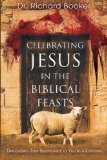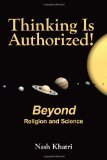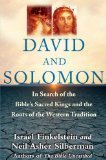Lee Harmon's Blog, page 140
January 26, 2011
Book review: Celebrating Jesus in the Biblical Feasts

 by Dr. Richard Booker
by Dr. Richard Booker★★★★
It's impossible to recognize all the nuances of the New Testament writings without understanding the Jewish feasts. Consider especially the Gospel of John: It goes from one Biblical feast to the next with barely a let-up. This is one of John's primary literary devices, where the festival celebrations provide a meaningful backdrop for Jesus' lessons. Let me give you an example from Booker's book, in his coverage of the Feast of Tabernacles:
As part of the ritual proceeding, a certain priest would draw water from the Pool of Siloam with a golden pitcher. He would then come to the altar at the temple where the High Priest would take the pitcher and pour the water into a basin at the foot of the altar. … About the time the water was being poured … [all the people] sought the Lord from Isaiah 44:3, which reads, "For I will pour water on him who is thirsty, and floods on the dry ground; I will pour my Spirit on your descendants, and my blessing on your offspring."
Now we come to the words of Jesus in John 7:37. Picture him there in the temple as the ceremony concludes. On the last day of the feast of Tabernacles, Jesus stood and cried out, "If anyone thirsts, let him come to me and drink. He who believes in me, as the Scripture has said, out of his heart will flow rivers of living water."
I have at least a half-dozen books about the feasts of Israel; it's a basic necessity for anyone studying to publish a book about the Gospel of John. With perhaps the exception of an over-sized picture book (come on, who can resist that?) this one is my favorite. Booker will guide you through the entire year of festivals, from Passover to Hanukkah, adroitly explaining the significance of each traditional and ritual and how the events relate to the story of Jesus.
(Dr. Richard Booker is considered a pioneer and spiritual father in teaching on Israel, Jewish-Christian relations, and the biblical Hebraic roots of Christianity.)
(click picture to buy on Amazon)
Published on January 26, 2011 07:46
January 25, 2011
Revelation 13:18
This calls for wisdom. If anyone has insight, let him calculate the number of the beast, for it is man's number. His number is 666.
//Most learned scholars of Revelation today recognize that, at least on some level, John names first-century Roman Emperor Nero Caesar as the Beast of Revelation. This verse provides one clue of many.
Here we find our infamous reference to the number 666 and John's command that the churches of Asia figure it out. Everyone knows this number identifies the Antichrist (as the Beast has since come to be known—Revelation never uses the term Antichrist). Clearly, John knows the Beast's identity and expects the seven churches to understand. A first-century spelling of Nero Caesar's name, written in Hebrew characters, sums to that exact value. Though perhaps hidden from Greek and Latin readers, this could not have gone unnoticed by Jewish Christians.
For anyone not familiar with this type of cryptogram, the basic idea builds upon the way Hebrew letters function as phonetic symbols for building words but also serve as numerals. All alphabetic symbols represent both a letter and a number. Roman numerals present perhaps our most familiar example of this, but in the Greek and Hebrew alphabets, all letters also stood for numbers, making this numerical wordplay quite popular. The letters of the Beast, N-R-W-N Q-S-R, written in Hebrew, become 50+200+6+50+100+60+200=666. This type of numerology, particularly among Rabbinic writings, proved irresistible for scriptural interpretations.
//Most learned scholars of Revelation today recognize that, at least on some level, John names first-century Roman Emperor Nero Caesar as the Beast of Revelation. This verse provides one clue of many.
Here we find our infamous reference to the number 666 and John's command that the churches of Asia figure it out. Everyone knows this number identifies the Antichrist (as the Beast has since come to be known—Revelation never uses the term Antichrist). Clearly, John knows the Beast's identity and expects the seven churches to understand. A first-century spelling of Nero Caesar's name, written in Hebrew characters, sums to that exact value. Though perhaps hidden from Greek and Latin readers, this could not have gone unnoticed by Jewish Christians.
For anyone not familiar with this type of cryptogram, the basic idea builds upon the way Hebrew letters function as phonetic symbols for building words but also serve as numerals. All alphabetic symbols represent both a letter and a number. Roman numerals present perhaps our most familiar example of this, but in the Greek and Hebrew alphabets, all letters also stood for numbers, making this numerical wordplay quite popular. The letters of the Beast, N-R-W-N Q-S-R, written in Hebrew, become 50+200+6+50+100+60+200=666. This type of numerology, particularly among Rabbinic writings, proved irresistible for scriptural interpretations.
Published on January 25, 2011 07:28
January 24, 2011
Book review: Thinking Is Authorized!
 by Nash Khatri
by Nash Khatri★★★★
With a mysterious Bang! 13.7 billion years ago, an incredible universe of time and space tumbled forth. Science and religion both are fascinated by this existence, as we humans peer ever deeper into the mysteries of the universe. But Nash's book is different: it wonders what else is out there. It invites us to contemplate what lies outside our prison of time and space. This concept is so key to the book that Nash has given it a label: Lack of Time and Space, or LTS.
The greatest mystery of LTS may be life itself. Life, Nash contends, is special; we'll never instill life in a robot, which will never be more than a construction in time and space. But where did life come from? How did emotion, thought, wonder, break into our world of time and space? Where does this life-matter go when we die? Is life truly eternal, existing in LTS? What does eternal mean where there is no time?
Nash Khatri meanders through these questions and more as he probes the mysteries of LTS. Nash obviously has a religious background, though he doesn't discuss it in the book. He at time appears apologetic (though he needn't be) for contradicting the beliefs of various religions. He points out the silliness of some of our age-old assumptions with both humor and respect.
At times, I would find myself asking: "Is this idea theologically sound?" And then, on the next page, "Is this idea scientifically sound?" You know, it really is hard to think beyond religion and science! In the end, I am unqualified to answer either question about the book, but thank you, Mr. Khatri, for encouraging me to think.
(click picture to buy on Amazon)

Published on January 24, 2011 07:59
January 23, 2011
II Samuel 21:17
And there was again a battle in Gob with the Philistines, where Elhanan the son of Jaareoregim, a Bethlehemite, slew [the brother of] Goliath the Gittite, the staff of whose spear was like a weaver's beam.
//Thus was the brother of Goliath slain. Or was he?
In the original Hebrew, it is Goliath himself who is slain by Elhanan! The words "the brother of" were added to the English translation of this verse to match I Chronicles 20:5, where it is Goliath's brother, and not Goliath himself, who was slain. These words do not exist in the original version in Samuel. Here is the NIV version of the same verse:
In another battle with the Philistines at Gob, Elhanan son of Jaare-Oregim the Bethlehemite killed Goliath the Gittite, who had a spear with a shaft like a weaver's rod.
So, who killed Goliath? Was it David, or was it Elhanan, one of David's elite men of war? Given that the writing of II Samuel precedes Chronicles by several centuries, the earliest tradition says Elhanan. Yet, somehow, the myth of David's great victory grew, and today has become a beloved story of courage for underdogs everywhere.
There are actually several clues in the Bible that hint the oldest tradition (Elhanan) is the true slayer of Goliath, but I won't go into them all here. Suffice it to say it's a fascinating study.
//Thus was the brother of Goliath slain. Or was he?
In the original Hebrew, it is Goliath himself who is slain by Elhanan! The words "the brother of" were added to the English translation of this verse to match I Chronicles 20:5, where it is Goliath's brother, and not Goliath himself, who was slain. These words do not exist in the original version in Samuel. Here is the NIV version of the same verse:
In another battle with the Philistines at Gob, Elhanan son of Jaare-Oregim the Bethlehemite killed Goliath the Gittite, who had a spear with a shaft like a weaver's rod.
So, who killed Goliath? Was it David, or was it Elhanan, one of David's elite men of war? Given that the writing of II Samuel precedes Chronicles by several centuries, the earliest tradition says Elhanan. Yet, somehow, the myth of David's great victory grew, and today has become a beloved story of courage for underdogs everywhere.
There are actually several clues in the Bible that hint the oldest tradition (Elhanan) is the true slayer of Goliath, but I won't go into them all here. Suffice it to say it's a fascinating study.
Published on January 23, 2011 10:35
January 22, 2011
Book review: The Existential Jesus

 by John Carroll
by John Carroll★★★★★
Ex-is-ten-tial –adjective: of or relating to existence, especially human existence.
This is Jesus, the way you've never read about him before. John Carroll draws primarily on the Gospel of Mark, a Gospel which rather quickly fell into disuse among early Christians as they favored the more majestic stories told by Matthew and the others.
Mark's Jesus is far more human. He sometimes questions, sometimes fails. He is ridiculed by his family. Carroll portrays Jesus as a lonely, mysterious stranger with an obscure mission. By the end of his journey, he has lost all of his followers. "His life reaches its consummation in tragedy—a godless and profane one—and a great death scream from the cross, questioning the sense of it all."
Mark's story then closes with a mystery. An empty tomb, and three women fleeing in terror, told to tell no one of what they saw—or didn't see. (Carroll is correct; the ending we have now in the book of Mark, describing the resurrection of Jesus, did not exist in the earliest manuscripts.)
Mark's Gospel is, of course, one of four. Over time, the Jesus story grew in splendor, and by the time the fourth Gospel was written, Jesus had become God Himself. When I complete my book about John's Gospel (yet a couple years away from publication), I am going to wander through every local bookstore and move my book next to Carroll's, where the two extremes can sit side-by-side.
(click picture to buy on Amazon)
Published on January 22, 2011 10:54
January 21, 2011
Jude 1:9
But even the archangel Michael, when he was disputing with the devil about the body of Moses, did not dare to bring a slanderous accusation against him, but said, "The Lord rebuke you!" What on earth is this verse all about? Michael and Satan squabbling over the body of Moses? According to Origin, an early 3rd-century church father, this verse in Jude references an apocryphal text known as the Assumption of Moses or the Ascension of Moses. We've never uncovered the ending to the Assumption of Moses; it's believed that about a third of the manuscript is missing, and many scholars therefore assume the story of Michael and Satan is in the lost ending. An alternative explanation is that Jude compounds ideas from multiple sources, playing on the general Jewish tradition of Michael as a gravedigger for the just. Michael "rebukes" Azazel in the book of Enoch, and an angel of the Lord "rebukes" Satan in Zechariah 3, so if we mix all the stories together, we get something akin to Jude's verse. Today's theologians often point out that Satan is the prince of this earth and, though the spirit of Moses ascended untouched to God, Satan stakes his claim to the bodies of believers. If so, why do you suppose Michael cared about this particular body? Is it because the location of Moses' burial is supposed to remain a mystery? In Deuteronomy 34, God buried him in Moab, in the valley opposite Beth Peor, but to this day no one knows where his grave is. Is Satan among those still looking for the lost body of Moses? Why would God take a special hand in Moses' burial? Something out of the ordinary was going on, and maybe we'll never know what this little tiff was about, but if you have opinions, I'd be curious to hear them.
Published on January 21, 2011 07:28
January 20, 2011
Book review: David and Solomon

 by Israel Finkelstein and Neil Asher Silberman
by Israel Finkelstein and Neil Asher Silberman★★★★
A Finkelstein book will be controversial; let's establish that up front. And because there exists very little archaeological evidence outside the Bible story of Judah's first kings, speculation will be a natural result of any such study. We know absolutely nothing from history about Saul and precious little about David and Solomon; in fact, the evidence is so sparse that a few scholars still doubt the existence of all three.
Finkelstein and Silberman don't doubt, but neither are they able to provide 342 pages of historical analysis. Instead, they trace the legends of these early kings through a thousand years of Hebrew writings, both in and out of the Bible. The earliest folklore and Bible verses about David show him as a bandit leader of a small gang of traveling raiders. Later authors portrayed David as a poet and a founder of a great dynasty, as well as a sinner. Solomon's reputation, as well, grew over time into a shrewd trader and wise sage.
How many of these writings are based on fact, and how many on legend? The authors' scholarly research and field experience will make you reconsider.
(click picture to buy on Amazon)
Published on January 20, 2011 07:12
January 19, 2011
Genesis 2:18
The Lord God said, "It is not good for the man to be alone. I will make a helper suitable for him."
//So God made Eve, right?
Nope, read your Bible. God made animals. Lots of them, and paraded them before Adam, so Adam could choose one for a "helper." Picture it: Along comes the giraffe. "Uh-uh." The hippo. "Forget it." The snake. "Ewww."
But for Adam no suitable helper was found. So the Lord God caused the man to fall into a deep sleep; and while he was sleeping, he took one of the man's ribs and closed up the place with flesh. Then the Lord God made a woman from the rib he had taken out of the man, and he brought her to the man.
And Adam said, "Yowza!" Well, ok, he really just mutters something about bones and flesh, but he seems happy. Adam spurns the giraffe, the hippo, the snake, and chooses the woman. What do you suppose happens next?
The ol' snake comes back, in an apparent jealous rage. He targets Eve, feeds her an evil apple, and Eve feeds Adam. Their eyes are opened to know good and evil. Now Adam says "Yowza!" Lo: Along came children, and the earth is populated.
I absolutely love this story! Religion was so much more fun back in those days, while God still wandered in His garden calling for His humans. Before God grew omni-everything and the snake grew satanic. Gimme that old-time religion!
//So God made Eve, right?
Nope, read your Bible. God made animals. Lots of them, and paraded them before Adam, so Adam could choose one for a "helper." Picture it: Along comes the giraffe. "Uh-uh." The hippo. "Forget it." The snake. "Ewww."
But for Adam no suitable helper was found. So the Lord God caused the man to fall into a deep sleep; and while he was sleeping, he took one of the man's ribs and closed up the place with flesh. Then the Lord God made a woman from the rib he had taken out of the man, and he brought her to the man.
And Adam said, "Yowza!" Well, ok, he really just mutters something about bones and flesh, but he seems happy. Adam spurns the giraffe, the hippo, the snake, and chooses the woman. What do you suppose happens next?
The ol' snake comes back, in an apparent jealous rage. He targets Eve, feeds her an evil apple, and Eve feeds Adam. Their eyes are opened to know good and evil. Now Adam says "Yowza!" Lo: Along came children, and the earth is populated.
I absolutely love this story! Religion was so much more fun back in those days, while God still wandered in His garden calling for His humans. Before God grew omni-everything and the snake grew satanic. Gimme that old-time religion!
Published on January 19, 2011 07:52
January 18, 2011
Book review: Pagan Christianity?
 by Frank Viola and George Barna
by Frank Viola and George Barna★★★★
No, this isn't a "bash the Christians" book. It's a "bash the church" book (lowercase "c"). The authors' goal is to redirect Christians back to the original teachings of the New Testament, where the "Church" was never a building.
"Pagan," as used by the authors, pretty much just means "different from what the New Testament teaches." Their goal is to encourage Christians to embrace the original New Testament church.
Church buildings are wrong. Sacraments are wrong. Collection plates are wrong. Pulpits are wrong. You'll get a earful, and if "wrong" means "not the way it was first done," then the authors have a well-researched point. But an important distinction needs to be made: The New Testament church, in this book, should not be confused with the "first century church." No extraneous Christian teachings are acceptable to Viola and Barna, who either ignore or condemn them. Even if some of these teachings are contemporary with New Testament writings. For example, church fathers Ignatius, Clement of Rome and Tertullian are criticized for introducing a clergy, and the Didache's instructions are never mentioned by the authors, who insist that early Christian worship sessions had no structure. Perhaps the authors subscribe to the view that all of the New Testament Gospels and epistles were written in Paul's time.
Part of the intrigue of this book, for me, is that I grew up in a nondenominational church similar to what the authors approve of as "organic," and that ignores all Christian instruction outside the Bible. This church has a bit more structure to their worship than what Viola and Barna recommend, but it does meet in homes and all members participate equally in the service. It's a "back to Jesus" movement patterned after the New Testament.
So, my church background may qualify me more than many reviewers to address both the pros and cons of the book's arguments. And as such, I do have one criticism, which drops it from a 5-star to a 4-star rating: The passion of the authors overflows, which should be a good thing, but here it's overwhelming. While they convincingly show that many Christian church customs differ from the first Christians, their underlying assumption that this is somehow bad gets pushed a little too hard for my taste, simply because in my experience, different church atmospheres and practices are appropriate for different people. We're all unique, and different things bring us closer to God.
But enough nit-picking. The book has a serious message for all who wish to pattern their manner of worship after the Bible.
(click picture to buy on Amazon)
Published on January 18, 2011 07:45
January 17, 2011
Acts 10:38
God anointed Jesus of Nazareth with the Holy Spirit and with power: who went around doing good and healing all who were under the power of the devil, for God was with him.
//Today's verse is a call for Christians to unite. Whether you see Jesus as a wandering first-century sage or a cosmic Christ, there is one attribute of his that all of us can agree on: compassion. Jesus cared. Jesus "went around doing good."
Whether "God" refers to a synonym for love or a white-bearded "Ancient of Days" looking down from the sky doesn't change the verse. Whether the "Holy Spirit" is a living, personal third of the Holy Trinity or a mysterious, warm presence bubbling up from within your being whenever your thoughts turn to compassion, may not be important. If you think of "casting out devils" as more of a figure of speech than a warfare against supernatural villains, you might be surprised that even some first-century Christians agree. There are no exorcisms or devils running amok in John's Gospel.
What we can all agree on is what Jesus taught: Kindness, compassion, love, respect. That's what it means to be a Christian.
//Today's verse is a call for Christians to unite. Whether you see Jesus as a wandering first-century sage or a cosmic Christ, there is one attribute of his that all of us can agree on: compassion. Jesus cared. Jesus "went around doing good."
Whether "God" refers to a synonym for love or a white-bearded "Ancient of Days" looking down from the sky doesn't change the verse. Whether the "Holy Spirit" is a living, personal third of the Holy Trinity or a mysterious, warm presence bubbling up from within your being whenever your thoughts turn to compassion, may not be important. If you think of "casting out devils" as more of a figure of speech than a warfare against supernatural villains, you might be surprised that even some first-century Christians agree. There are no exorcisms or devils running amok in John's Gospel.
What we can all agree on is what Jesus taught: Kindness, compassion, love, respect. That's what it means to be a Christian.
Published on January 17, 2011 07:51



